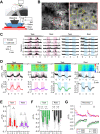Neural Mechanism Underlying Task-Specific Enhancement of Motor Learning by Concurrent Transcranial Direct Current Stimulation
- PMID: 35908004
- PMCID: PMC9849633
- DOI: 10.1007/s12264-022-00901-1
Neural Mechanism Underlying Task-Specific Enhancement of Motor Learning by Concurrent Transcranial Direct Current Stimulation
Abstract
The optimal protocol for neuromodulation by transcranial direct current stimulation (tDCS) remains unclear. Using the rotarod paradigm, we found that mouse motor learning was enhanced by anodal tDCS (3.2 mA/cm2) during but not before or after the performance of a task. Dual-task experiments showed that motor learning enhancement was specific to the task accompanied by anodal tDCS. Studies using a mouse model of stroke induced by middle cerebral artery occlusion showed that concurrent anodal tDCS restored motor learning capability in a task-specific manner. Transcranial in vivo Ca2+ imaging further showed that anodal tDCS elevated and cathodal tDCS suppressed neuronal activity in the primary motor cortex (M1). Anodal tDCS specifically promoted the activity of task-related M1 neurons during task performance, suggesting that elevated Hebbian synaptic potentiation in task-activated circuits accounts for the motor learning enhancement. Thus, application of tDCS concurrent with the targeted behavioral dysfunction could be an effective approach to treating brain disorders.
Keywords: Motor learning; Neural mechanism of tDCS; Neuronal excitability; Stroke model mouse; tDCS effect.
© 2022. Center for Excellence in Brain Science and Intelligence Technology, Chinese Academy of Sciences.
Conflict of interest statement
The authors declare no conflicts of interest.
Figures





Similar articles
-
Transcranial direct-current stimulation combined with attention increases cortical excitability and improves motor learning in healthy volunteers.J Neuroeng Rehabil. 2020 Feb 19;17(1):23. doi: 10.1186/s12984-020-00665-7. J Neuroeng Rehabil. 2020. PMID: 32075667 Free PMC article.
-
Effects of anodal transcranial direct current stimulation over lower limb primary motor cortex on motor learning in healthy individuals.Eur J Neurosci. 2018 Apr;47(7):779-789. doi: 10.1111/ejn.13866. Epub 2018 Mar 6. Eur J Neurosci. 2018. PMID: 29443433
-
Transcranial direct current stimulation in stroke - Motor excitability and motor function.Clin Neurophysiol. 2022 Dec;144:16-22. doi: 10.1016/j.clinph.2022.09.003. Epub 2022 Sep 17. Clin Neurophysiol. 2022. PMID: 36208617
-
The Effect of a Single Session of Non-Invasive Brain Stimulation on Balance in Healthy Individuals: A Systematic Review and Best Evidence Synthesis.Brain Connect. 2021 Nov;11(9):695-716. doi: 10.1089/brain.2020.0872. Epub 2021 Sep 3. Brain Connect. 2021. PMID: 33798002
-
The acute effects of motor cortex transcranial direct current stimulation on athletic performance in healthy adults: A systematic review and meta-analysis.Eur J Neurosci. 2024 Sep;60(5):5086-5110. doi: 10.1111/ejn.16488. Epub 2024 Aug 9. Eur J Neurosci. 2024. PMID: 39120435
Cited by
-
Research trends and hotspots of post-stroke upper limb dysfunction: a bibliometric and visualization analysis.Front Neurol. 2024 Oct 2;15:1449729. doi: 10.3389/fneur.2024.1449729. eCollection 2024. Front Neurol. 2024. PMID: 39416663 Free PMC article.
-
Effect of transcranial direct current stimulation with concurrent cognitive performance targeting posterior parietal cortex vs prefrontal cortex on working memory in schizophrenia: a randomized clinical trial.Transl Psychiatry. 2024 Jul 8;14(1):279. doi: 10.1038/s41398-024-02994-w. Transl Psychiatry. 2024. PMID: 38977683 Free PMC article. Clinical Trial.
-
Transcranial electrical stimulation (TES) in human motor Optimization: Mechanisms, safety, and emerging applications.Biochem Biophys Rep. 2025 Jun 2;43:102055. doi: 10.1016/j.bbrep.2025.102055. eCollection 2025 Sep. Biochem Biophys Rep. 2025. PMID: 40519699 Free PMC article. Review.
-
Resolving inconsistent effects of tDCS on learning using a homeostatic structural plasticity model.Front Netw Physiol. 2025 Jul 7;5:1565802. doi: 10.3389/fnetp.2025.1565802. eCollection 2025. Front Netw Physiol. 2025. PMID: 40692813 Free PMC article.
-
Transcranial low-intensity ultrasound stimulation for treating central nervous system disorders: A promising therapeutic application.Front Neurol. 2023 Mar 8;14:1117188. doi: 10.3389/fneur.2023.1117188. eCollection 2023. Front Neurol. 2023. PMID: 36970512 Free PMC article. Review.
References
-
- Kuo MF, Paulus W, Nitsche MA. Therapeutic effects of non-invasive brain stimulation with direct currents (tDCS) in neuropsychiatric diseases. Neuro Image. 2014;85(Pt 3):948–960. - PubMed
-
- Fregni F, Boggio PS, Mansur CG, Wagner T, Ferreira MJL, Lima MC, et al. Transcranial direct current stimulation of the unaffected hemisphere in stroke patients. Neuro Report. 2005;16:1551–1555. - PubMed
MeSH terms
LinkOut - more resources
Full Text Sources
Miscellaneous

